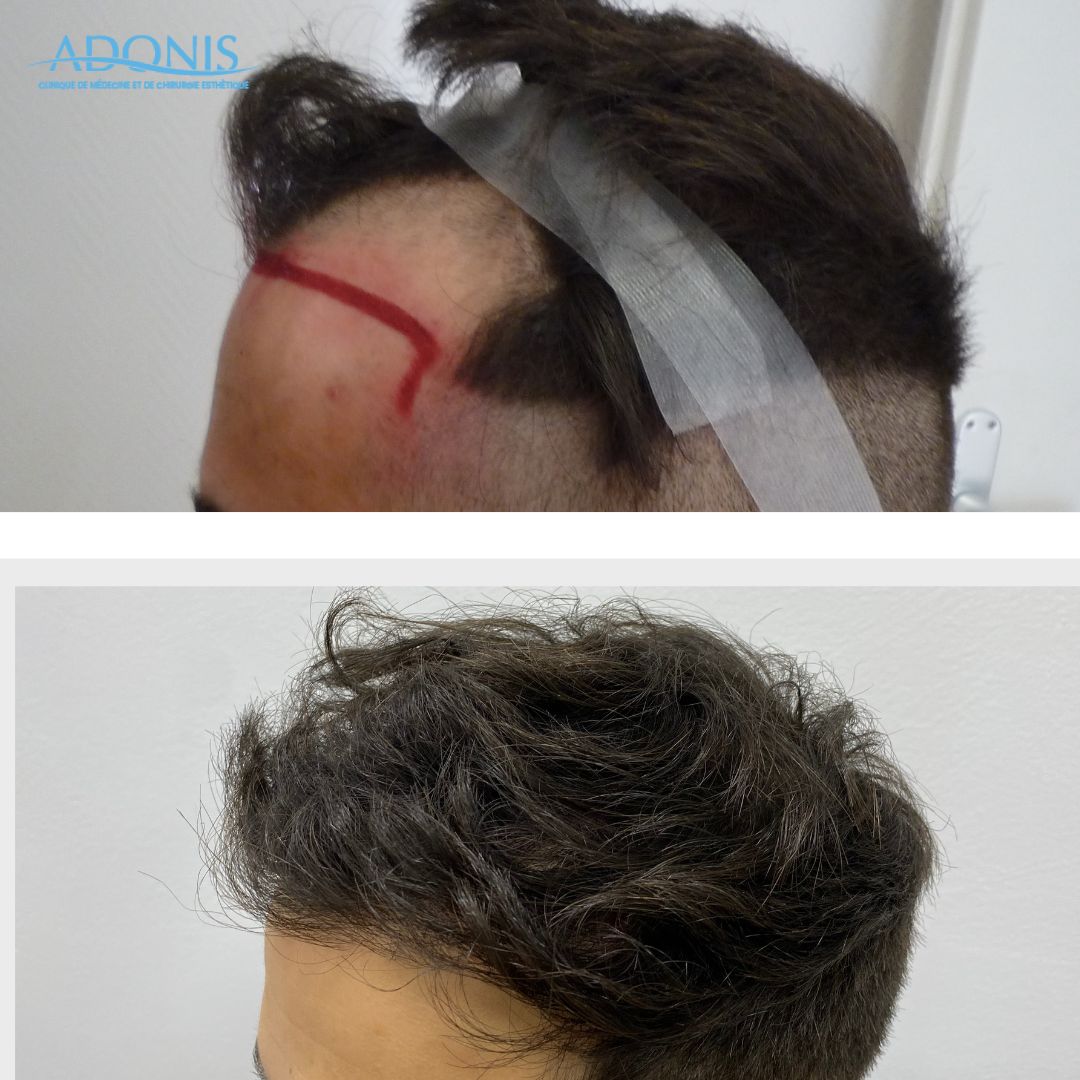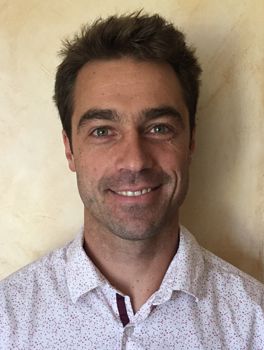Rediscover the joy of
thick hair
Excellence in hair transplantation for over 30 years
At Adonis Clinic, we recognize the uniqueness of each patient and tailor our hair transplant services to meet a variety of needs. Our skilled team conducts a thorough assessment of your hair situation and initiates an open discussion about your expectations, carefully guiding you at every step. We develop personalized solutions, designed to align with your hair type, hair density, and aesthetic goals, while emphasizing that results can vary from one individual to another.
Two methods aimed at achieving a natural look
| The FUE Method (Follicular Unit Extraction) The FUE method is a technique that allows for hair transplantation while minimizing visible scarring. Using micro-instruments, our specialists carefully select and extract hair follicles from the donor area, often located at the back of the head. These follicles are then reimplanted in areas requiring densification, aiming to blend seamlessly with the natural hair. The results vary based on several factors, including hair texture and the recipient area, and will be discussed in detail during the initial consultation to ensure a full understanding of expectations and possible outcomes. |
|
The FUT Technique |
Here’s a glimpse of the results you can attain






Hair transplantation
in 4 Steps
1.
Start by requesting an initial free consultation with our specialist by filling out the form on this page.
2.
Visit Adonis clinic, where the specialist will meet with you to understand your motivations and assess the hair treatment best suited to your situation.
3.
You will receive a detailed quote by email. Once you have accepted it, your treatment will be scheduled over several sessions, depending on your specific needs.
4.
Our doctors have over
30 years of combined experience

DR. FABIAN EVENS
Aesthetic and Body Contouring Surgeon
Tummy tuck
body lift
breast volume augmentation
(fat grafting and implants)
liposuction.
Aesthetic Physician:
Hair transplant specialist

DR. ANTOINE GROSDIDIER
Aesthetic and Body Contouring Surgeon
Tummy tuck,
body lift
breast volume augmentation
(fat grafting and implants)
liposuction
Aesthetic Physician:
Hair transplant specialist

DR. ANTOINE BORNHAUSER
General Internal Medicine
Member of the Swiss Society
of Aesthetic Medicine
Aesthetic Medicine:
Hair transplant specialist
Hair Surgery
3 reasons to choose
Adonis Clinic for
your hair transplant
Experience and Expertise
Holistic Approach
We consider hair transplantation as a comprehensive process. We assess your overall health, hair history, and expectations to develop an effective treatment plan.
Comfort and Safety
Your well-being is our absolute priority. We ensure that you feel comfortable throughout your hair transplant journey and implement strict protocols to guarantee your safety and satisfaction.
FAQ
How much does a hair transplant cost?
At Adonis Clinic, the price of a hair transplant starts from CHF 1500.
The cost of a hair transplant can vary depending on several factors, such as the technique used, the extent of hair loss, the reputation and experience of the surgeon, etc. It is not possible to provide a precise figure without knowing these specific details.
Generally, hair transplants are priced based on the number of grafts or follicular units needed to achieve the desired results. The cost can be expressed per graft or per grafting session.
Can patients pay in installments?
For patients in Switzerland, it is possible to benefit from a monthly installment payment option with Swiss Billing.
What is the duration of a hair transplant?
The duration of a hair transplant can vary depending on several factors such as the technique used, the quantity of hair to be transplanted, and the complexity of the individual case. Generally, a hair transplant session can last from a few hours to a full day.
Follicular Unit Extraction (FUE) hair transplant may take longer compared to Follicular Unit Transplantation (FUT) due to the individual follicular hair extraction process.
The exact duration of the hair transplant will be determined during your initial consultation with the expert. They will assess your specific situation, discuss your goals, and provide an estimate of the time needed to perform the procedure.
It is important to note that hair transplantation is a meticulous procedure that requires special attention and precision to achieve optimal results. The duration of the hair transplant may seem lengthy, but it is essential to allow the surgeon to work carefully and ensure successful hair grafts.
Does a hair transplant hurt?
Hair transplantation is typically performed under local anesthesia, meaning you should not feel pain during the procedure itself. However, some patients may experience a slight tingling sensation, pressure, or discomfort during the administration of local anesthesia or during the extraction and transplantation of hair follicles.
After the hair transplant, it is normal to experience some sensitivity, mild pain, or discomfort in the donor area and in the transplanted areas. However, these symptoms are usually mild and can be easily managed with painkillers prescribed by your surgeon.
It is important to note that everyone has a different pain tolerance, and individual reactions may vary. If you have concerns about the pain associated with hair transplantation, it is recommended to openly discuss your concerns with your expert. They can provide you with detailed information on pain management before, during, and after the procedure, and adjust treatments accordingly to ensure your optimal comfort.
How many months after the procedure are the results visible?
The results of a hair transplant are not immediately visible. After the procedure, the transplanted hair undergoes a temporary resting phase called ‘shedding of grafts.’ Approximately two to four weeks after the transplant, the transplanted hair begins to fall out, which may seem concerning. However, this is part of the normal healing process.
After the initial shedding, the hair follicles enter a regrowth phase. It may take several months before the transplanted hair starts to grow visibly. Generally, patients can expect to see the first signs of hair regrowth between three and four months after the transplant.
It is important to note that hair regrowth is a gradual and continuous process. Hair will continue to thicken and grow over time. The final results of the hair transplant are typically visible between nine and twelve months after the procedure, although this may vary from individual to individual.
It is essential to be patient and follow your hair surgeon’s recommendations regarding post-operative care and follow-up consultations. This will help maximize results and achieve a natural and satisfying hair appearance in the long term.
3 reasons why it might be preferable to choose FUE hair transplantation:
- No visible scarring: One of the main differences between FUE and FUT lies in the resulting scars. With FUE, hair follicles are individually extracted using precision instruments, resulting in small incisions that heal quickly. In contrast, FUT involves taking a strip of hair and leaves a larger linear scar. If you prefer to avoid visible scars, FUE is often the preferred choice.
- Shorter recovery time: FUE hair transplantation generally offers a shorter recovery time compared to FUT. Since FUE does not require sutures or stitches, healing is quicker, with less post-operative discomfort. This means you can return to your normal activities more quickly after FUE hair transplantation, which can be an advantage for individuals with an active lifestyle.
- Flexibility and versatility: The FUE technique allows hair surgeons to extract individual follicles from various parts of the donor area, offering greater flexibility and better utilization of available hair resources. This can be particularly beneficial for individuals with a limited reserve of donor hair. Additionally, FUE also allows hair transplantation to be performed in more specific areas, providing greater precision in designing the hairline and better adaptation to individual aesthetic needs. It is important to note that the decision between FUE and FUT will depend on several factors, such as your specific needs, the amount of available donor hair, and the recommendations of your hair surgeon. A thorough consultation with a trusted professional will help determine the best approach for your hair transplantation goals.
What are the recommended post-operative care?
Here are some tips to promote optimal healing and achieve the best possible results:
- Protection and hygiene: Avoid touching or scratching the grafted area to prevent any infection or injury. Keep the area clean by following the specific instructions provided by your surgeon. Use gentle shampoos and avoid irritating hair products.
- Avoid intense physical activities: Steer clear of sports and exercises that may exert pressure or traction on the grafted area. This helps reduce the risk of trauma or damage to the grafts.
- Sun protection: Shield your scalp from the sun by wearing a hat or using a sunscreen specifically designed for the scalp. Overexposure to the sun can damage the grafts and affect the results of the hair transplant.
- Medical follow-up: Ensure you attend the scheduled follow-up appointments with your surgeon. These consultations allow for monitoring of healing, assessment of hair regrowth, and discussion of any potential issues or concerns.
- Avoid tobacco and alcohol: Refrain from smoking and consuming alcohol during the recovery period, as they can affect blood circulation and the healing process.
- Healthy diet: Adopt a balanced diet rich in nutrients to promote optimal recovery. Make sure to consume sufficient proteins, vitamins, and essential minerals.

It all starts here
Get in touch with us


